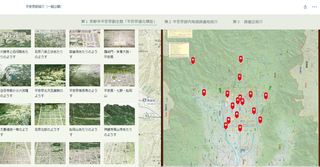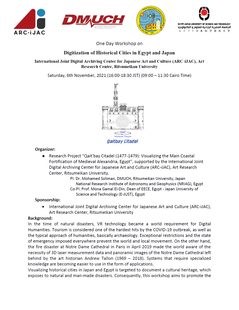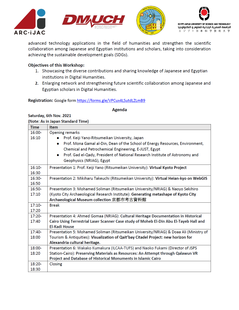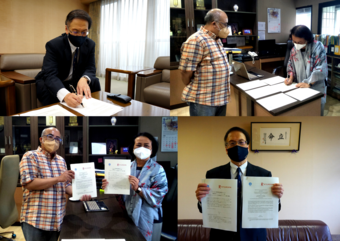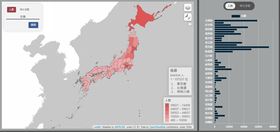-
 16
17
18
19
20
21
22
23
24
25
26
16
17
18
19
20
21
22
23
24
25
26
 [イベント情報]December 9, 2021(Thu)
[イベント情報]December 9, 2021(Thu)
The Art Research Center (ARC) and the Institute of Disaster Mitigation for Urban Cultural Heritage (R-DMUCH), Ritsumeikan University, are delighted to announce the release of the Heian-kyo Site Database. This web-based platform contains the results of research on the Heian-kyo excavation sites.
Features of the Heian-kyo Site Database:
1. Construction of an open data infrastructure that "allows anyone to learn about Heian-kyo whenever and wherever they want".
2. Visualization of the results of more than 5,000 excavations of the Heian-kyo site.
3. Aiming at creating a virtual environment where the public can freely contribute to and publish information related to Heian-kyo in the future.
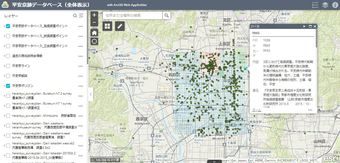 In collaboration with the Kyoto City Lifelong Learning Center, the ARC and the R-DMUCH have been conducting research by utilizing the 'Model of a Reconstruction of Heian-kyo' exhibited at the Heian-kyo Sousei-kan in Kyoto (京都市平安京創生館), amongst others.
In collaboration with the Kyoto City Lifelong Learning Center, the ARC and the R-DMUCH have been conducting research by utilizing the 'Model of a Reconstruction of Heian-kyo' exhibited at the Heian-kyo Sousei-kan in Kyoto (京都市平安京創生館), amongst others.A large amount of excavation research related to Heian-kyo has been carried out mainly by the Kyoto City Archaeological Research Institute. The purpose of our database is to visualize the results of this research on an online map, which anyone can freely access and download.
Therefore, this is a platform where "anyone can learn about Heian-kyo whenever and wherever they want".
The map displays various excavation sites and contains approximately 5,000 research summary documents. About 400 of these sites can be viewed by overlaying the excavation plans with a map of modern Kyoto.
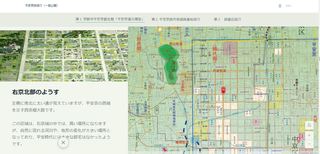 The Geographical Information System (GIS) data on this site, including excavation sites, excavation plans, and restoration drawings, are available for download as open data. Furthermore, we present a 'Heian-kyo Site Story Map' that gives insights into the history of the various excavation sites.
The Geographical Information System (GIS) data on this site, including excavation sites, excavation plans, and restoration drawings, are available for download as open data. Furthermore, we present a 'Heian-kyo Site Story Map' that gives insights into the history of the various excavation sites.In the future, we will continue to add new digitized archaeological information, and we aim to create an environment where the public can freely contribute and publish information related to Heian-kyo.
<<Access Heian-kyo Site Database>>
<<Access Heian-kyo Story Map>>
*This database has been built with ArcGIS Hub by Esri and was launched on November 25, 2021.
On December 8, 2021, the Yomiuri Shimbun featured an article on the launch of the Heian-kyo Site Database--a project led by Prof. Keiji Yano, Deputy Director of the Art Research Center (ARC).
For more information on the database, please click here.
[イベント情報]November 16, 2021(Tue)The 93rd International ARC Seminar, held on November 10, 2021 is now available on YouTube.
The program was as follows:
Topic: Introducing an album of preliminary drawings by Katsushika Isai (葛飾為斎)
Speaker: Dr. Ellis TINIOS (Honorary Lecturer, University of Leeds, United Kingdom and ARC Visiting Researcher)
We hope you enjoy the video!
[イベント情報]November 6, 2021(Sat)We kindly invite you to join the one-day workshop Digitization of Historical Cities in Egypt and Japan.
Date: Saturday, November 6, 2021 16:00-18:30 JST (09:00 - 11:30 Cairo Time)
Organizer: Research Project Qait'bay Citadel (1477-1479): Visualizing the Main Coastal Fortification of Medieval Alexandria, Egypt, supported by the International Joint Digital Archiving Center for Japanese Art and Culture (ARC-iJAC), Art Research Center, Ritsumeikan University.
PI: Dr. Mohamed Soliman, DMUCH, Ritsumeikan University, Japan / National Research Institute of Astronomy and Geophysics (NRIAG), Egypt
Co-PI: Prof. Mona Gamal El-Din, Dean of EECE, Egypt - Japan University of Science and Technology (E-JUST), Egypt
Sponsorship: International Joint Digital Archiving Center for Japanese Art and Culture (ARC-iJAC), Art Research Center, Ritsumeikan University
Registration: Via Google Forms https://forms.gle/VPCux4LSutdLZLmB9
Background: In the time of natural disasters, VR technology became a world requirement for Digital Humanities. Tourism is considered one of the hardest hits by the COVID-19 outbreak, as well as the typical approach of humanities, basically archaeology. Exceptional restrictions and the state of emergency imposed everywhere prevent the world and local movement. On the other hand, the fire disaster at Notre Dame Cathedral in Paris in April 2019 made the world aware of the necessity of 3D laser measurement data and panoramic images of the Notre Dame Cathedral left behind by the art historian Andrew Tallon (1969 - 2018). Systems that require specialized knowledge are becoming easier to use in the form of applications.
Visualizing historical cities in Japan and Egypt is targeted to document a cultural heritage, which exposes to natural and man-made disasters. Consequently, this workshop aims to promote the advanced technology applications in the field of humanities and strengthen the scientific collaboration among Japanese and Egyptian institutions and scholars, taking into consideration achieving the sustainable development goals (SDGs).
Objectives of this workshop: (1) Showcasing the diverse contributions and sharing knowledge of Japanese and Egyptian institutions in Digital Humanities. (2) Enlarging network and strengthening future scientific collaboration among Japanese and Egyptian scholars in Digital Humanities.
Agenda
Saturday, November 6, 2021
(Note: As in Japan Standard Time)
Time Item 16:00-
16:10Opening remarks
● Prof. Keiji Yano-Ritsumeikan University, Japan
● Prof. Mona Gamal al-Din, Dean of the School of Energy Resources, Environment, Chemical and Petrochemical Engineering, E-JUST, Egypt
● Prof. Gad el-Qady, President of National Research Institute of Astronomy and Geophysics (NRIAG), Egypt
16:10-
16:30Presentation 1: Prof. Keiji Yano (Ritsumeikan University): Virtual Kyoto Project 16:30-
16:50Presentation 2: Mikiharu Takeuchi (Ritsumeikan University): Virtual Heian-kyo on WebGIS 16:50-
17:10Presentation 3: Mohamed Soliman (Ritsumeikan University/NRIAG) & Naoyo Sekihiro (Kyoto City Archaeological Research Institute): Generating metashape of Kyoto City Archaeological Museum collection 京都市考古資料館 17:10- 17:20 Break 17:20-17:40 Presentation 4: Ahmed Gomaa (NRIAG): Cultural Heritage Documentation in Historical Cairo Using Terrestrial Laser Scanner Case study of Moheb El-Din Abu El-Tayeb Hall and El-Kadi House 17:40-18:00 Presentation 5: Mohamed Soliman (Ritsumeikan University/NRIAG) & Doaa Ali (Ministry of Tourism & Antiquities): Visualization of Qait'bay Citadel Project: new horizon for Alexandria cultural heritage. 18:00-18:20 Presentation 6: Wakako Kumakura (ILCAA-TUFS) and Naoko Fukami (Director of JSPS Station-Cairo): Preserving Materials as Resources: An Attempt through Qalawun VR Project and Database of Historical Monuments in Islamic Cairo 18:20-18:30 Closing [イベント情報]October 28, 2021(Thu)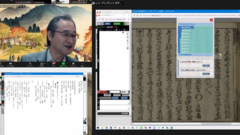 An online kickoff seminar to mark the beginning of the Kuzushiji Training Course Phase 2 was held on Friday, October 22, 2021.
An online kickoff seminar to mark the beginning of the Kuzushiji Training Course Phase 2 was held on Friday, October 22, 2021.The event was hosted by the International Joint Digital Archiving Center for Japanese Art and Culture (ARC-iJAC), Art Research Center, Ritsumeikan University in cooperation with the International Research Center for Japanese Studies (Nichibunken).
The objective of the second phase is to support seminar participants in obtaining hands-on experience in the ARC Transcription Support System through individual projects of transcribing literary works that they have selected in the ARC Early Japanese Book Portal Database.
Following opening remarks by ARC Deputy Director Professor Ryo Akama (College of Letters), Professor Hiroshi Araki of the International Research Center for Japanese Studies (Nichibunken) gave a special lecture on '本を「ツナグ」 ―「くずし字」のデジタル・ネットワーキングへー'.
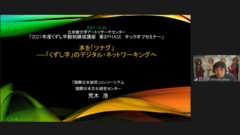
After that, the project leaders of the participating kuzushiji projects, and the tutors who will provide guidance and feedback during the second phase of the training course introduced themselves, their projects, and areas of specialty.
This event was supported by the 'International Exchange Program for Young Researchers through Reading Early Japanese Books and Documents (Deciphering Kuzushiji)' adopted by the Consortium for Global Japanese Studies.
For further information, read the interview with Prof. Ryo Akama on the Kuzushiji Training Course and the ARC Transcription Support System: https://www.arc.ritsumei.ac.jp/e/news/pc/008080.html
[イベント情報]October 21, 2021(Thu)Kyoto Shimbun reported on Assistant Professor Hirotaka Sato (College of Letters)--a member of the Art Research Center--who has 'restored' the landscape of Yumiya-cho in the early Meiji era with a digital archive. Yumiya-cho is located in the Higashiyama district of Kyoto.
[イベント情報]October 21, 2021(Thu)On October 21, 2021, the Kyoto Shimbun featured an article on the digital archiving of films that belonged to the late Aimi Akira, initiated by Associate Professor Shinya Saito (College of Image Arts and Sciences)--a member of the Art Research Center.
Professor Saito plans to create a database on these films as part of his project Kyoto Street Culture Archive: Memories of the Pop Culture Featuring the Streets, and their Visualization.
[イベント情報]October 18, 2021(Mon)The Art Research Center (ARC) is delighted to announce the conclusion of a Memorandum of Understanding (MoU) with the Research Center for Area Studies, Indonesian Institute of Sciences (P2W-LIPI).
A Framework for Collaborative Projects in Digital Humanities
The new MoU builds upon our first MoU signed with LIPI for four years in 2017 and marks a continuation of the successful and fruitful collaboration of both institutions thus far.
The MoU provides a stable framework to advance our collaborative projects in digital humanities, including the research and archival projects on Borobudur Temple, Liyangang site, and Punjulharjo site in Indonesia.
Furthermore, the MoU supports the organization of joint symposia, seminars, and conferences, as well as the exchange of scientists and scientific materials pertaining to our collaborative projects.
Project Spotlight: Digital Archiving of Borobudur Temple, a UNESCO World Heritage
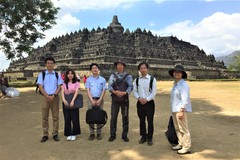 On the ARC side, Professor Satoshi Tanaka (College of Information Science and Engineering) has been leading the digital archiving project of Borobudur Temple that encompasses the ultra-high-quality 3D see-through visualization of this large-scale UNESCO World Heritage Site.
On the ARC side, Professor Satoshi Tanaka (College of Information Science and Engineering) has been leading the digital archiving project of Borobudur Temple that encompasses the ultra-high-quality 3D see-through visualization of this large-scale UNESCO World Heritage Site."Since we are the first foreign scientist team to conduct a 3D scanning of this vast archaeological site, it is a significant international joint research project for the Art Research Center," says Professor Tanaka.
He plans to create a next-generation, ultra-high-definition virtual reality tour of the temple compounds that will be made available on the internet and in local community centers in Indonesia, and a dynamical time-series visualization of the temple's building process.
→ Interview with Professor Satoshi Tanaka on Visualizing Large-Scale Cultural Heritage: https://www.arc.ritsumei.ac.jp/e/news/pc/007293.html
[イベント情報]October 17, 2021(Sun)The crowdfunding initiative of Shochiku Otani Library in Tokyo that Professor Ryo Akama--Deputy Director of the Art Research Center--has been supporting in its digital-archiving activities was featured in the Tokyo Shimbun on October 17, 2021.
The article introduces the 10th anniversary of the crowdfunding initiative that aims at digitizing and making online available severely damaged materials in the library collection.
Nearly half of the donations for the crowdfunding initiative have been made by repeated users, and the number of young users who came to know about the library through crowdfunding has steadily increased.
[イベント情報]October 13, 2021(Wed)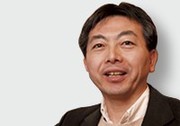 The Art Research Center (ARC), Ritsumeikan University, is delighted to announce the release of the 'Surname Map'--a research project led by Professor Keiji Yano (College of Letters), Deputy Director of the ARC.
The Art Research Center (ARC), Ritsumeikan University, is delighted to announce the release of the 'Surname Map'--a research project led by Professor Keiji Yano (College of Letters), Deputy Director of the ARC.Project Background
Until the end of the Edo period, Japanese surnames had exclusively been granted to the emperor, nobility, and samurais. Following the Meiji Restoration and the enactment of the family registration law in the early Meiji period, farmers and other commoners also began to adopt surnames.
With more than 100,000 different surnames, Japan is not only characterized by great diversity in surnames but also regional variations in their distribution.
Based on big data of about 40 million surnames from Japanese telephone directories and large-scale residential maps, the Surname Map visualizes the contemporary spatial distribution of surnames across all prefectures in Japan.
This research began in 2005 when Professor Yano, then a visiting researcher at University College London (UCL), joined Professor Paul Longley's research project on surnames around the world at the Department of Geography, UCL.
Professor Longley had mapped surnames from the UK's 1881 Census of Individual Voters and the 1998 Electoral Roll to analyze the movement of surnames over more than a hundred years.
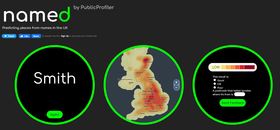
In the UK, a country with an ethnically diverse population, he measured ethnic residential segregation by inferring ethnic origins from surnames.
For the project of Professor Longley to create a world map of surnames, Professor Yano provided the Japanese surnames.
Features of the Surname Map
The interactive map provides users with valuable insights into the geographic distribution of their individual surnames in a simple and illustrative manner.
Firstly, the map displays the frequency of a surname in absolute numbers (人数) and ranking according to prefectures.
Secondly, the map shows the relative degree of accumulation, i.e., how evenly a surname is distributed throughout the country, with the specialization coefficient (特化係数).
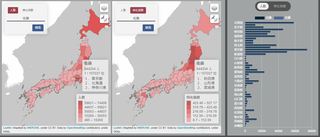
An option is available to display the absolute numbers and specialization coefficient on two maps side by side.
Furthermore, the distribution trends of two surnames can be compared side by side.
Explore Regional Variations
The map enables users to explore and identify the geographic concentration and regional clusters of surnames.
For instance, the map reveals that some surnames are particularly unique to a region, such as 'Ganaha' (我那覇) in Okinawa.
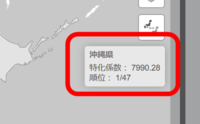
In the case of Okinawa, the heavy concentration of 'Ganaha' (我那覇) has been considered a result of the relative isolation of the Ryukyu Islands that has led to minimal surname exchange with mainland Japan, whereas there are different reasons for other localities, such as government policy implications on the settlement of Hokkaido.
Current & Future Research Endeavors
Professor Yano's Surname Map builds on the growing interest in the regional analysis of surnames in Japan and other parts of the world.
As in the UK, there exists no exhaustive historical surname data for the whole country in Japan. For Kyoto, however, a database has been created as part of the Virtual Kyoto Project--another project led by Professor Yano. He is working on establishing links within this data that comprise name data from land registry maps from the end of the Meiji period (1868-1912), telephone directories, and the names of people in commerce and industry during the Taisho period (1912-1926).
Other projects include an investigation in the hometowns of the Tonden soldiers (屯田兵) and migration flows of their descendants, identifying the hometowns of Nikkei (日系人) who emigrated from Japan, as well as a study of population movements in local areas of Japan over the past fifteen years, linking them to the census data at town and village levels.
Finally, Professor Yano is pursuing the possibility of digital humanities research on surnames, including the relationship between surnames and the name of places.
<Access the UK project 'Named by PublicProfiler' of University College London (UCL)>
The Surname Map has been created by Ritsumeikan University in cooperation with Acton Winds Co., Ltd.
Further reading:
1. Cheshire, James A., Paul A. Longley, Keiji Yano, and Tomoya Nakaya. "Japanese surname regions." Papers in Regional Science 93 (2014): 539-555. https://doi.org/10.1111/pirs.12002.
2. Longley, Paul. A., Alex D. Singleton, Keiji Yano, and Tomoya Nakaya. "Lost in Translation: Cross-Cultural Experiences in Teaching Geo-Genealogy." Journal of Geography in Higher Education 34, no. 1 (2010): 21-38. https://doi.org/10.1080/03098260902982476.
3. Yano, Keiji. "GIS based Japanese family name maps and their potential in Geographic Information Science." Jinmoncom (2007): 47-54. http://id.nii.ac.jp/1001/00100574/. (in Japanese with English abstract)
 16
17
18
19
20
21
22
23
24
25
26
16
17
18
19
20
21
22
23
24
25
26



